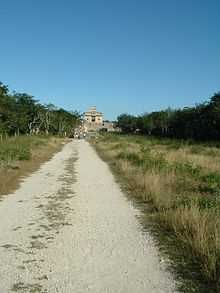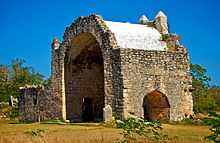Dzibilchaltun





Location
In the view of modern researchers, the ancient builders of Dzibilchaltún may have chosen the site of the city to be as close as possible to the coastal salt-producing region (some 22 km away), while still being located on a reasonably fertile and habitable terrain. The region between Dzibilchaltún and the sea coast is less suitable for human habitation, being either mangrove swamps or bare rock.[1]
Overview
The site has been continuously occupied for thousands of years, although it has expanded and contracted from mid-sized city to small town more than once in its long history. It is about 30 minutes from Mérida and the famous sea that supposedly was the site of impact of the meteorite that killed the dinosaurs.
Architecture
The most famous structure is the Temple of the Seven Dolls, so named because of seven small effigies found at the site when the temple was discovered under the ruins of a later temple pyramid by archaeologists in the 1950s.[2] On the vernal equinox, the sun rises so that it shines directly through one window of the temple and out the other. This is a similar event to the descending snake of Chichen Itza designed to show the power of the gods.[citation needed] The temple is connected to the rest of the site by a sacbe, or "white road," so-called because they were originally coated with white limestone, built over stone-and-rubble fill.
Surroundings
The other major feature of Dzibilchaltún is its cenote, Cenote Xlakah, located around the center of the city's ruins. It is thought that the availability of this source of clean drinking water influenced the builders' choice of the location. Archaeological findings retrieved from the cenote by divers indicate that it was the center of a religious cult.[1][2] These days the cenote is used as a swimming hole by local residents and tourists year round.
Dzibilchaltún also contains the ruin of a 16th-century Spanish church built at the site after the conquest.
The Dzibilchaltun archeological site also includes a visitor center with maps, restrooms and gift shops. The renovated museum housing Mayan artifacts located at the site has re-opened.
References
- ↑ 1.0 1.1 Kurjack, Edward (2001), "Dzibilchaltún (Yucatán, Mexico)", in Evans, Susan Toby; Webster, David L., Archaeology of ancient Mexico and Central America: an encyclopedia, Taylor & Francis US, pp. 227–228, ISBN 0-8153-0887-6
- ↑ 2.0 2.1 Burgess, Robert F. (1999). "Through the Bottom of the Ocean". The Cave Divers. Locust Valley, New York: Aqua Quest Publications. pp. 71–84. ISBN 1-881652-11-4. LCCN 96-39661.
| Wikimedia Commons has media related to Dzibilchaltun. |
Coordinates: 21°5′27.60″N 89°35′25.08″W / 21.0910000°N 89.5903000°W
